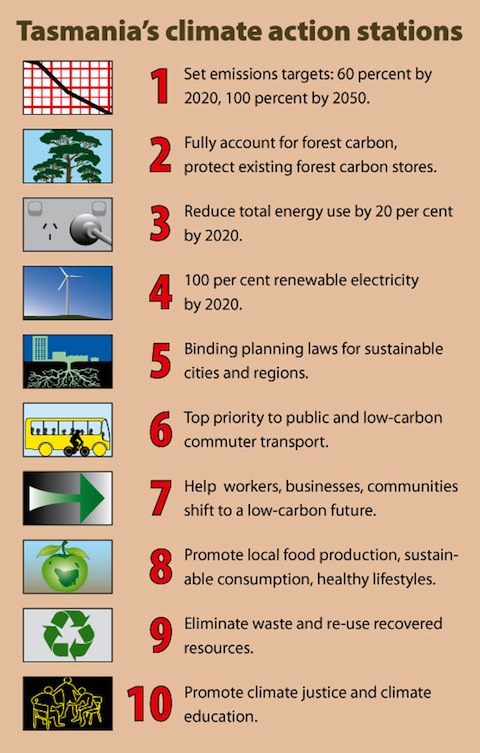Tasmanians seeking an effective climate action policy now have something to get their teeth into. A broad-based group has established ten strategies to make the island carbon-neutral by 2050. [20 October 2009 | Peter Boyer]
 On a sunny Saturday morning a couple of weekends ago, about 50 people got together in Hobart to talk about climate change. Climate meetings are regular events these days, but I predict that this one will be remembered long after its time.
On a sunny Saturday morning a couple of weekends ago, about 50 people got together in Hobart to talk about climate change. Climate meetings are regular events these days, but I predict that this one will be remembered long after its time.
The context of this meeting is important. This year has seen the climate debate become noisier and more acrimonious as the message from science becomes clearer: turn today’s upward emissions trajectory around within a precious few years, or face climate chaos.
Many politicians have not taken the debate seriously. Many have treated climate change as just another soft green issue, requiring a few meaningless assurances before being shelved yet again.
Most of them have been caught short when asked what they really think about it. A few die-hards have even donned the Inquisitor’s mantle and determined the science to be fraudulent.
The end result has been a policy vacuum. True, we have Canberra’s contentious “Carbon Pollution Reduction Scheme” along with a handful of feel-good climate measures, and we have Tasmania’s “Framework for Action” and a legislated 2050 target. But nothing out of either government looks remotely like making the dramatic emissions shift demanded by the science.
It’s true that taking a leadership role in this debate calls for political courage. There is much junk to be broken through and many established mindsets to overturn. Such a leader must disturb some long-standing centres of power and wealth, a prospect that would put most politicians to flight.
Courage and a clear voice. Facing powerful enemies in the early 1940s, democratic leaders set aside their manuals of government and spoke honestly about the awful challenge ahead, calling on people to give their all in defence of the nation. Their words resound still, in this far-off 21st century. So who among today’s leaders has the fortitude and grace to make that clarion call for climate action?
People who have taken the trouble to get acquainted with the evidence know that human-induced climate change exceeds the threat of any past war or depression. And as the Hobart “Climate Action Forum” demonstrated, some are preparing to grab the microphone and step into the breach.
Organised by a new group called Climate Action Hobart and supported by Sustainable Living Tasmania, the October 10 forum was designed to start a deliberate, determined, substantive policy debate on climate in the lead-up to next year’s State election.
The word went out into Tasmanian networks that this would be a meeting to take seriously. It was to determine the 10 most important actions required to get Tasmania on track to meet the level of emissions reduction now demanded by the science.
In a full day’s program, the forum chewed over how to ensure the ten points contained the right mix of critical actions to bring real emissions cuts — as opposed to that other kind designed to reassure the minders and bean-counters.
Looking at targets, it found the State 2050 target seriously lacking. It agreed to targets for reducing total energy use (20 per cent by 2020, carbon neutrality by 2050) and achieving a 100 per cent renewable electricity target by 2020.
It examined the crucial need for a transparent process of accounting for forestry emissions, for creating binding State-wide planning policies for a sustainable built environment, and for giving public and low-carbon transport the status and support it deserves. Leaders, take note.
Governments have failed to deal adequately with the climate challenge because leaders have not appreciated the depth of public concern. Next Saturday, politicians around the world (including Tasmania) will have a chance to get some insight into this by observing ordinary people making a show of themselves in the cause of turning the juggernaut around.
The International Day of Climate Action supports scientists’ call for a 350 parts-per-million ceiling on carbon dioxide levels with a day of public demonstration culminating in a “visual petition” of photographs from around the world on the global 350.org website. For more information on Tasmanian “350” events check the Happenings column at right.
Ten actions to turn around Tasmanian carbon emissions
The Climate Action Forum determined the following ten urgent actions to be essential components in a workable emissions-reduction policy for Tasmania:
Action 1: Set targets, with detailed plans, to reduce Tasmanian greenhouse gas emissions by 60 percent by 2020 over 1990 levels, and to achieve carbon neutrality by 2050.
Action 2: Establish a transparent, verifiable carbon accounting regime for forestry activities in Tasmania while protecting existing carbon stores in native forests.
Action 3: Prepare a strategy to reduce total energy use in Tasmania by 20 per cent by 2020.
Action 4: Prepare a strategy to achieve 100 per cent renewable electricity in Tasmania by 2020.
Action 5: Introduce binding State planning legislation to promote sustainable cities and regions in Tasmania.
Action 6: Invest in public and low-carbon transport to make it the preferred mode of commuter transport.
Action 7: Facilitate transitions to a low-carbon future for Tasmanian workers, businesses and communities.
Action 8: Prepare a strategy to promote sustainable local food production, sustainable consumption and healthy lifestyles.
Action 9: Prepare a strategy to eliminate waste and re-use recovered resources in Tasmania.
Action 10: Promote climate justice and climate education in Tasmania.
